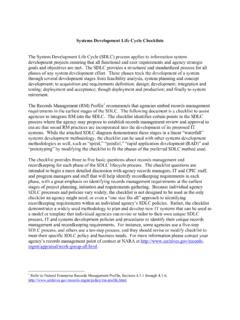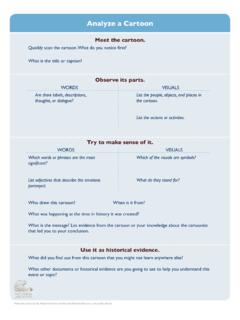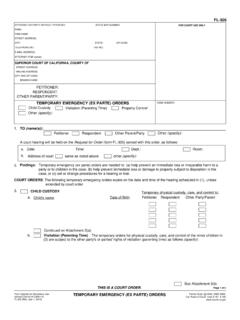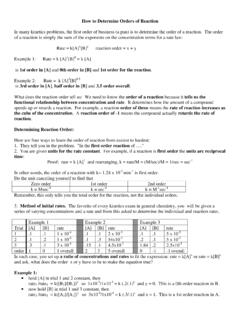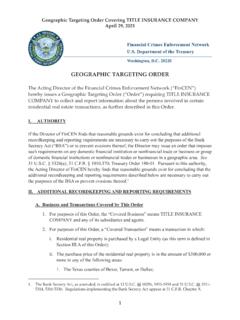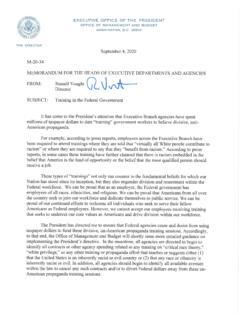Transcription of Federal Register Presidential Documents - Archives
1 Presidential Documents Federal RegisterVol. 58, No. 190 Monday, October 4, 1993 Title 3 The PresidentExecutive Order 12866 of September 30, 1993 Regulatory Planning and ReviewThe American people deserve a regulatory system that works for them,not against them: a regulatory system that protects and improves their health,safety, environment, and well-being and improves the performance of theeconomy without imposing unacceptable or unreasonable costs on society;regulatory policies that recognize that the private sector and private marketsare the best engine for economic growth.
2 Regulatory approaches that respectthe role of State, local, and tribal governments; and regulations that areeffective, consistent, sensible, and understandable. We do not have sucha regulatory system this Executive order, the Federal Government begins a program toreform and make more efficient the regulatory process. The objectives ofthis Executive order are to enhance planning and coordination with respectto both new and existing regulations; to reaffirm the primacy of Federalagencies in the regulatory decision-making process; to restore the integrityand legitimacy of regulatory review and oversight; and to make the processmore accessible and open to the public.
3 In pursuing these objectives, theregulatory process shall be conducted so as to meet applicable statutoryrequirements and with due regard to the discretion that has been entrustedto the Federal , by the authority vested in me as President by the Constitutionand the laws of the United States of America, it is hereby ordered asfollows:Section 1. Statement of Regulatory Philosophy and Principles.(a) The Regulatory Philosophy. Federal agencies should promulgate onlysuch regulations as are required by law, are necessary to interpret the law,or are made necessary by compelling public need, such as material failuresof private markets to protect or improve the health and safety of the public,the environment, or the well-being of the American people.
4 In decidingwhether and how to regulate, agencies should assess all costs and benefitsof available regulatory alternatives, including the alternative of not and benefits shall be understood to include both quantifiable measures(to the fullest extent that these can be usefully estimated) and qualitativemeasures of costs and benefits that are difficult to quantify, but neverthelessessential to consider. Further, in choosing among alternative regulatory ap-proaches, agencies should select those approaches that maximize net benefits(including potential economic, environmental, public health and safety, andother advantages; distributive impacts; and equity), unless a statute requiresanother regulatory approach.
5 (b) The Principles of Regulation. To ensure that the agencies regulatoryprograms are consistent with the philosophy set forth above, agencies shouldadhere to the following principles, to the extent permitted by law andwhere applicable:(1) Each agency shall identify the problem that it intends to address(including, where applicable, the failures of private markets or publicinstitutions that warrant new agency action) as well as assess the signifi-cance of that problem.(2) Each agency shall examine whether existing regulations (or other law)have created, or contributed to, the problem that a new regulation isVerDate 27<APR>2000 13:16 Jan 31, 2001 Jkt 000000 PO 00000 Frm 00001 Fmt 4705 Sfmt 4790 O:\EO\HTML\EOSGML~1\ ofrpc12 PsN: ofrpc12 Federal Register / Vol.
6 58, No. 190 / Monday, October 4, 1993 / Presidential Documentsintended to correct and whether those regulations (or other law) shouldbe modified to achieve the intended goal of regulation more effectively.(3) Each agency shall identify and assess available alternatives to directregulation, including providing economic incentives to encourage the de-sired behavior, such as user fees or marketable permits, or providinginformation upon which choices can be made by the public.(4) In setting regulatory priorities, each agency shall consider, to theextent reasonable, the degree and nature of the risks posed by varioussubstances or activities within its jurisdiction.
7 (5) When an agency determines that a regulation is the best availablemethod of achieving the regulatory objective, it shall design its regulationsin the most cost-effective manner to achieve the regulatory objective. Indoing so, each agency shall consider incentives for innovation, consistency,predictability, the costs of enforcement and compliance (to the government,regulated entities, and the public), flexibility, distributive impacts, andequity.(6) Each agency shall assess both the costs and the benefits of the intendedregulation and, recognizing that some costs and benefits are difficult toquantify, propose or adopt a regulation only upon a reasoned determinationthat the benefits of the intended regulation justify its costs.
8 (7) Each agency shall base its decisions on the best reasonably obtainablescientific, technical, economic, and other information concerning the needfor, and consequences of, the intended regulation.(8) Each agency shall identify and assess alternative forms of regulationand shall, to the extent feasible, specify performance objectives, ratherthan specifying the behavior or manner of compliance that regulated enti-ties must adopt.(9) Wherever feasible, agencies shall seek views of appropriate State, local,and tribal officials before imposing regulatory requirements that mightsignificantly or uniquely affect those governmental entities.
9 Each agencyshall assess the effects of Federal regulations on State, local, and tribalgovernments, including specifically the availability of resources to carryout those mandates, and seek to minimize those burdens that uniquelyor significantly affect such governmental entities, consistent with achievingregulatory objectives. In addition, as appropriate, agencies shall seek toharmonize Federal regulatory actions with related State, local, and tribalregulatory and other governmental functions.(10) Each agency shall avoid regulations that are inconsistent, incompatible,or duplicative with its other regulations or those of other Federal agencies.
10 (11) Each agency shall tailor its regulations to impose the least burdenon society, including individuals, businesses of differing sizes, and otherentities (including small communities and governmental entities), consist-ent with obtaining the regulatory objectives, taking into account, amongother things, and to the extent practicable, the costs of cumulative regula-tions.(12) Each agency shall draft its regulations to be simple and easy tounderstand, with the goal of minimizing the potential for uncertaintyand litigation arising from such 2.


